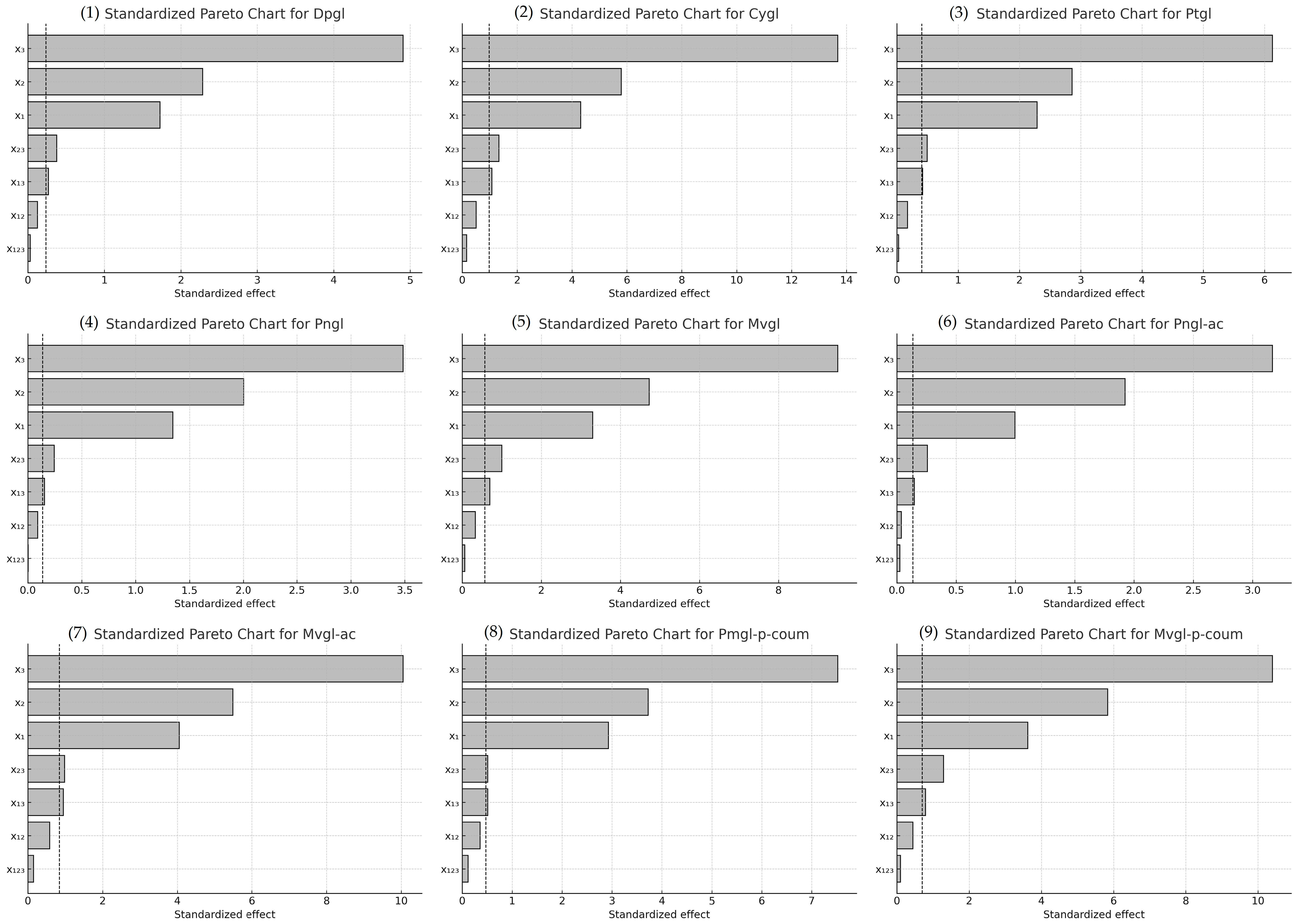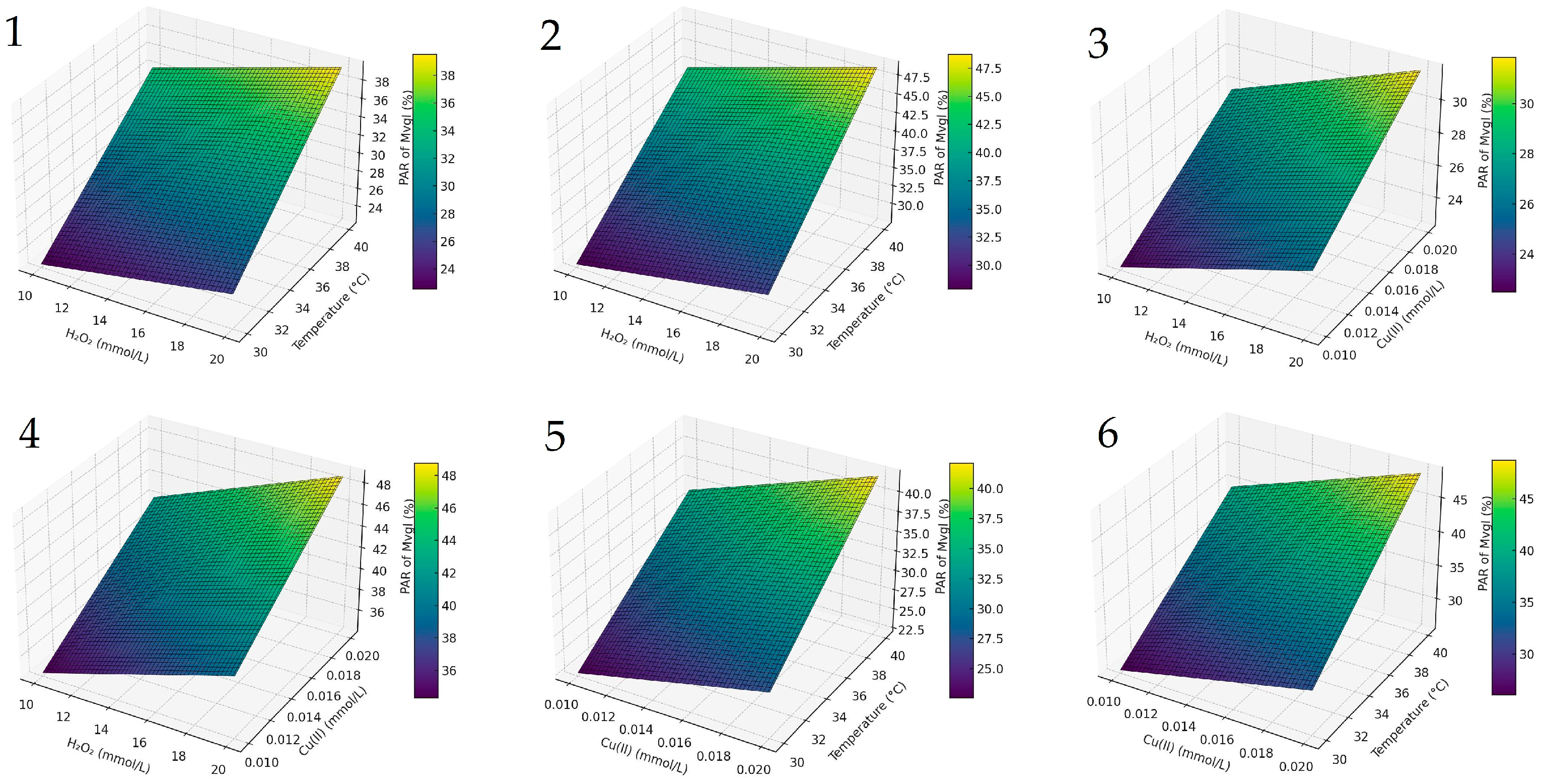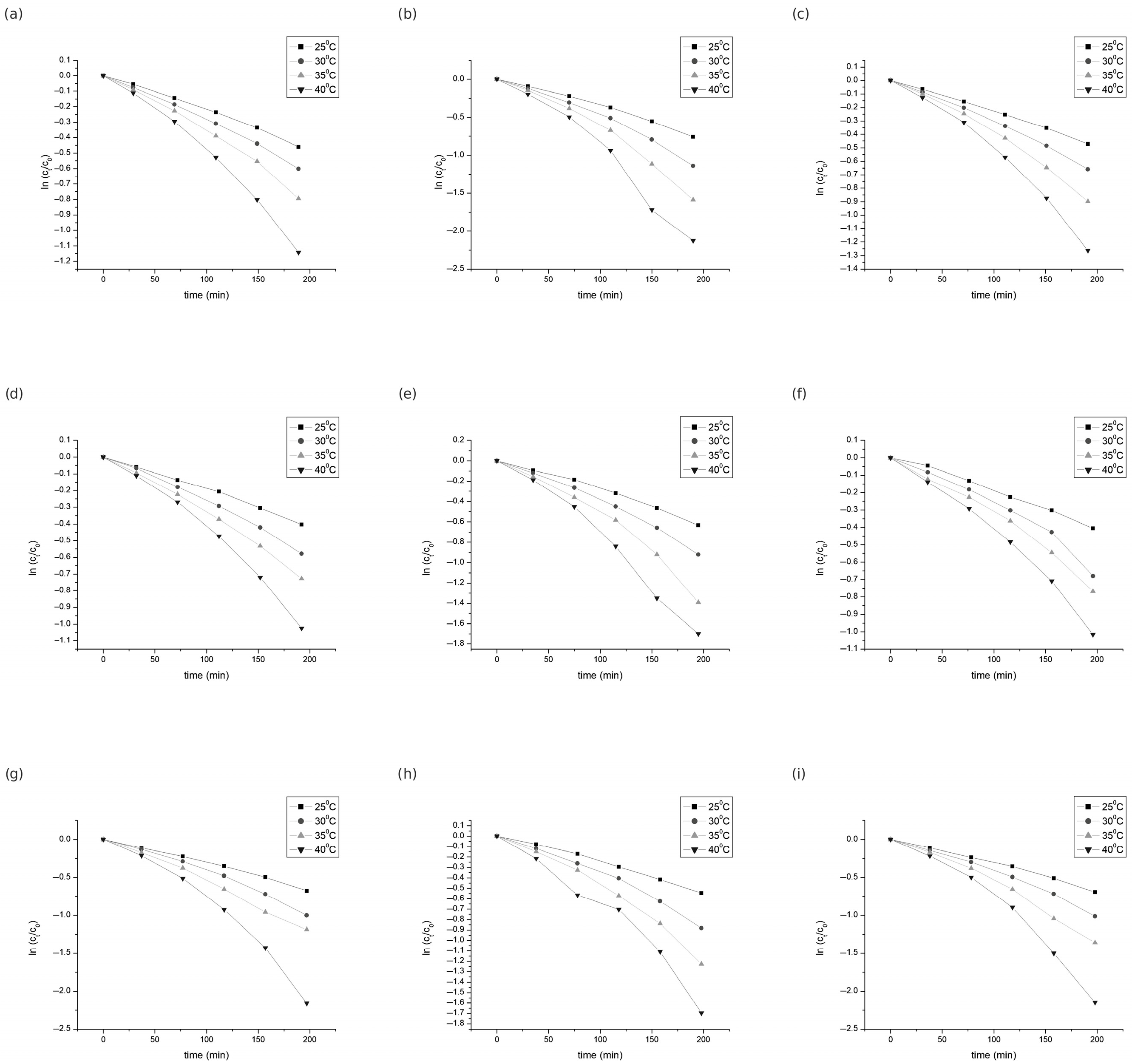1. Introduction
Anthocyanins (Greek: anthos (άνθος) = flower and kianeos (κυανός) = blue) belong to the group of flavonoids among the polyphenols, which are responsible for the red and blue color of grape berries and wine [
1]. The dominant anthocyanins are derivatives of malvidin—malvidin-3-
O-glucoside (Mvgl) and malvidin-3,5-
O-diglucoside. Malvidin-3,5-
O-diglucoside is characteristic of some hybrid grape varieties and young wines from Eurasian cultivated vines (
Vitis vinifera L.). In red wine, the most important are glycosides of five anthocyanidins: delphinidin-3-
O-glucoside (Dpgl), cyanidin-3-
O-glucoside (Cygl), petunidin-3-
O-glucoside (Ptgl), peonidin-3-
O-glucoside (Pngl), and malvidin-3-
O-glucoside, while pelargonidin-3-
O-glucoside is absent or present only in trace amounts [
2,
3]. Anthocyanin compounds are responsible for certain organoleptic characteristics such as color, bitterness, and astringency of wine. Since the color of wine is a common quality criterion, the analysis of these pigments has attracted considerable attention [
4,
5].
Anthocyanins are water-soluble pigments from the phenol group that occur as secondary metabolic products in plants. They contribute to the coloring of flowers and fruits, help with pollination and seed dispersal, and play a role in plant development. Due to their broad color spectrum—from red to violet to blue—they are often used as natural dyes in various industries. Anthocyanins also have useful biological properties, including antioxidant and antimicrobial activity. However, their practical use is limited by their low stability, which is affected by factors such as pH, light, temperature, oxygen, enzymes, ascorbic acid, sulphites, and co-pigments [
6].
Due to their unsaturated chemical structure, anthocyanins are very susceptible to oxidation through reactions with molecular oxygen. Oxygen is therefore a crucial factor influencing their stability, as its presence can accelerate the degradation of anthocyanins. In red wine, oxidative processes occur throughout production—during fermentation, aging in the barrel, and storage in the bottle—which influence both the chemical composition and the sensory properties of the final product. These reactions have a significant influence on the color of the wine [
7,
8] and its organoleptic properties [
9].
Throughout the winemaking process, the wine is exposed to different amounts of oxygen, each of which influences its chemical evolution. Due to the complex interplay between the composition of the wine and its oxidative reactivity, it is still difficult to predict the exact effects of a given oxygen dose. Nevertheless, the results presented in this study provide practical insights that can help predict the behavior of anthocyanins and overall wine stability under defined oxidative conditions.
Oxygen is a key factor in wine production, especially in the post-fermentation stages. The highest oxygen exposure typically occurs during bottling, where the dissolved oxygen content can reach about 3.0–4.1 mg/L under controlled saturation conditions [
10,
11]. During the subsequent oxidative reactions, molecular oxygen (O
2) is gradually reduced to water via a series of steps, producing reactive intermediates such as hydrogen peroxide (H
2O
2) and hydroxyl radicals (HO•). These reactive oxygen species can initiate the oxidation of various wine components and thus influence the composition and stability of the wine [
12,
13,
14].
Transition metals such as iron and copper are frequently present in wine and originate from various sources such as vineyard soils, pesticide treatments against
Plasmopara viticola disease, winemaking equipment, and environmental influences. These metals can catalyse oxidative reactions by activating molecular oxygen and thus influence the stability and quality of wine [
15]. Globally, iron concentrations in wine range from 0.061 to 50 mg/L, while copper concentrations range from undetectable to around 6.8 mg/L. Iron is primarily taken up by the grapevine from the soil and transferred to the wine during processing, while copper is often introduced using copper-based fungicides in viticulture [
15].
The simultaneous presence of hydrogen peroxide and transition metals such as iron and copper in wine can lead to the formation of Fenton’s reagent, a highly reactive oxidizing system. While limited data are available on the combined effects of H
2O
2, Cu (II), and temperature on anthocyanin stability in red wine, this study fills this gap by investigating their effects on anthocyanin degradation in Serbian ‘Merlot’ cv. wine. The degradation kinetics are analyzed using a thermodynamic framework that incorporates the following main activation parameters: Gibbs free energy (ΔG*), enthalpy (ΔH*), entropy (ΔS*), and activation energy (Ea). These parameters enable a deeper understanding of the thermal stability and degradation behavior of anthocyanins in complex food matrices such as wine. Although the oxidative degradation of anthocyanins has previously been studied in systems involving Fe (II) and other transition metals [
16,
17], there is a lack of data specifically addressing Cu (II)-catalyzed degradation under realistic wine conditions, which represents the novelty of our approach.
Therefore, the present study aims to characterize the anthocyanin composition of red wine from the ‘Merlot’ variety and to determine the oxidative degradation of individual anthocyanins through a controlled process of accelerated aging using hydroxyl radicals generated in the presence of Cu (II) as a catalyst. The research provides a better understanding of the stability of the anthocyanin compounds in ‘Merlot’ wine and the associated changes in oenological potential during the aging process under oxidative conditions.
2. Materials and Methods
2.1. Wine Sample Origin and Storage Conditions
The red wine used was a commercial Merlot (Vitis vinifera L.), produced using standard vinification procedures including alcoholic and malolactic fermentation. Sulfur dioxide (SO2) was added at 50 mg/L. The wine was aged in stainless steel tanks for 12 months and bottled in dark glass bottles with screw caps under inert conditions.
Before the experiment, the wine was stored for 3 months in the dark at 15 ± 1 °C to minimize further oxidation. Although dissolved oxygen was not quantified, all degradation experiments were conducted in sealed Budarin-type reaction vessels to ensure that oxidative conditions were controlled. The wine matrix was characterized by pH 3.4, ethanol content 13.5%, and typical phenolic composition.
2.2. Chemicals and Reagents
All reagents were of analytical grade. Copper (II) chloride dihydrate (CuCl2•2H2O, ≥99%), hydrogen peroxide (30% w/w, p.a.), acetonitrile (≥99.9%, HPLC grade), formic acid (≥98%) and anthocyanin glucoside standards (purity ≥ 95%) were purchased from Merck (Darmstadt, Germany) and Sigma-Aldrich (St. Louis, MO, USA). The solutions were prepared using deionized water from a MicroMed high-purity water system (TKA Wasseraufbereitungssysteme GmbH, Niederelbert, Germany).
A Cu (II) stock solution (1.0 × 10−3 mol/L) was prepared by dissolving CuCl2•2H2O in deionized water. The hydrogen peroxide solution (0.979 mol/L) was freshly prepared from a commercial 30% stock solution immediately before use to ensure stability.
2.3. High-Performance Liquid Chromatography (HPLC-DAD) Analysis
Anthocyanin compounds were quantified by reversed-phase high-performance liquid chromatography (RP-HPLC) with diode array detection. The analysis was performed using an Agilent 1200 Series HPLC system (Agilent Technologies, Singapore) equipped with a UV–Vis diode array detector (DAD) for simultaneous monitoring of multiple wavelengths.
Sample injections of 5 µL were made onto an Eclipse XDB C18 column (4.6 × 150 mm, Agilent) maintained at 25 °C. Gradient elution was performed with two mobile phases: Solvent A (2% formic acid in water) and Solvent B (a mixture of 80% acetonitrile, 2% formic acid, and water). The elution profile was programmed as follows: 0–10 min, 0% B; 10–28 min, linear gradient from 0% to 25% B; 28–30 min, 25% B; 30–35 min, 25% to 50% B; 35–40 min, 50% to 80% B; and 40–45 min, re-equilibration back to 0% B.
Anthocyanins were identified by comparing both retention times (Dpgl- 22.04; Cygl- 22.60; Pngl- 25.32; Mvgl- 26.85 min.) and UV–Vis spectra with those of authentic standards. The quantification was based on an external calibration. The analytical parameters, such as calibration curves, coefficients of determination (R
2), limits of detection (LOD), and limits of quantification (LOQ), are listed in
Table 1. The results are expressed in mg/L of red wine.
The concentrations of the individual anthocyanins were determined using calibration curves generated from authentic standards. For compounds for which no specific standard exists, quantification was performed using calibration data from structurally related analogues. For example, peonidin-3-O-glucoside was used as a reference for petunidin-3-O-glucoside. Similarly, delphinidin-3-O-glucoside, cyanidin-3-O-glucoside, peonidin-3-O-glucoside, and malvidin-3-O-glucoside were used to estimate the concentrations of their corresponding acetylated and p-coumaroylated derivatives. All measurements were performed in triplicate to ensure the reproducibility and reliability of results.
2.4. Reaction Conditions
A full factorial design (2
3) with replication was used to investigate the influence of three variables on the degradation of anthocyanins in red wine. Two concentration levels of hydrogen peroxide (10 and 20 mmol/L), two levels of Cu (II) (0.01 and 0.02 mmol/L), and two reaction temperatures (30 °C and 40 °C) were investigated. Based on preliminary investigations, the factor levels were selected to ensure that the reaction time would allow for chromatographic measurements at five different time points. The three factors—H
2O
2 concentration (x
1), Cu (II) concentration (x
2) and reaction temperature (x
3)—and their respective maximum and minimum values are summarized in
Table 2,
Table 3 and
Table 4, where the coded values (−1) and (+1) represent the lower and upper levels, respectively.
The degradation of each anthocyanin was monitored over an oxidation period of 70 min oxidation period (adjusting the system from the start of the reaction to account for the retention time of each peak), and the response variable was defined as the percentage of anthocyanin reduction (PAR). The experimental matrix with the corresponding PAR values for each treatment combination is shown in
Table 2,
Table 3 and
Table 4.
2.5. Anthocyanin Kinetic Degradation in the Presence of Hydroxyl Radicals
The kinetic degradation of red wine anthocyanins in the presence of hydroxyl radicals—generated by a Fenton-like system involving Cu (II) and H2O2—was studied at four different temperatures: 25, 30, 35, and 40 °C. The experiment was carried out in a Budarin vessel with four chambers. The Budarin vessel enabled separate thermostating of each component and precise timing of the reaction start. Cu (II) solution was added to one chamber, hydrogen peroxide to the second, red wine to the third, and a mixture of buffer solution (tartaric acid, pH 3.5) and deionized water (total volume: 2 mL) to the fourth. Prior to analysis, the wine sample was filtered through a 0.45 μm membrane filter. The vessel was thermostatted at the selected temperature (±0.1 °C) for 5 min. All reagents were freshly prepared and handled under subdued light to prevent photo-induced degradation. After equilibration, the contents of all four chambers were combined and stirred for 60 s. The resulting solution was immediately transferred to the chromatography cell, and the change in peak area was measured at 520 nm as a function of reaction time. All measurements were performed in triplicate to ensure analytical reliability and reproducibility.
2.6. Determination of Kinetic Parameters
In accordance with previous studies, anthocyanins follow first-order degradation kinetics (at constant H
2O
2 and Cu (II) concentration):
where
t is the time (min),
k is the pseudo first order kinetic rate constant (min
−1), and
and
are the anthocyanin content (mg/L) at time zero and
t, respectively.
The decimal reduction time (
D-value), which is the time needed for a tenfold reduction in the initial concentration at a given temperature, is related to k-values according to Equation (2):
The half-life (
t1/2) value of degradation is given by Equation (3):
2.7. Thermodynamic Analysis
The temperature and degradation constant are related according to the Arrhenius equation:
where
k is the rate constant of the degradation reaction,
A denotes the pre-exponential (Arrhenius) factor,
Ea is the apparent activation energy,
R represents the universal gas constant, and
T is the absolute temperature. By applying the natural logarithm to both sides of the Arrhenius equation,
Equation (4) is obtained. When the natural logarithm of the degradation constant compared with the inverse of the absolute temperature is plotted according to Equation (4), the
Ea value from the slope and the
lnA value from the ordinate intercept are obtained. Thus, the thermodynamic parameters change in enthalpy (Δ
H*), entropy (Δ
S*), and free energy of activation (Δ
G*) are obtained using the following equations:
where
h (6.6262 1034 J s) is Planck’s constant and
kB (1.3806 1023 J K1) is Boltzmann’s constant. From Equations (6) and (7), it is possible to calculate the activation entropy (
):
2.8. Statistical Analysis
The experimental data were statistically analyzed using Design-Expert® software (Stat-Ease, Inc., Minneapolis, MN, USA). A full factorial experimental design (23) with replication was used to evaluate the influence of three factors—hydrogen peroxide concentration, Cu (II) concentration, and reaction temperature—on the percentage of anthocyanin reduction (PAR). The significance of each factor and its interactions was evaluated using analysis of variance (ANOVA). In addition, first-order linear regression models were developed to describe the relationship between PAR and the experimental factors, including their interaction terms.
4. Conclusions
The degradation of anthocyanins in Serbian ‘Merlot’ red wine under oxidative conditions followed first-order kinetics, with rate constants ranging from 0.00197 to 0.01113 min−1, depending on temperature and anthocyanin structure. The activation energy (Ea) values varied between 40.58 and 56.62 kJ/mol, indicating moderate thermal sensitivity. Reaction temperature had the strongest influence on degradation rates, with Cygl being the most susceptible to oxidation. In contrast, Pngl and its derivatives demonstrated higher thermal and oxidative stability. Among the acylated anthocyanins, Mvgl-ac showed lower stability compared to Pngl-ac. A similar pattern was observed for their p-coumaroylated forms, with malvidin-based derivatives degrading more rapidly.
These findings highlight the role of anthocyanin structure in determining oxidative stability. From a practical standpoint, controlling oxygen exposure and metal ion content—particularly copper—during both vineyard management and winemaking is essential for preserving anthocyanin integrity and ensuring color stability in red wines. Reducing excessive copper residues—e.g., by managing pesticide inputs—and optimizing micro-oxygenation during fermentation and aging could help maintain anthocyanin composition and support the production of high-quality wines. These findings provide guidance for winemakers aiming to enhance shelf life, color stability, and overall market competitiveness.










